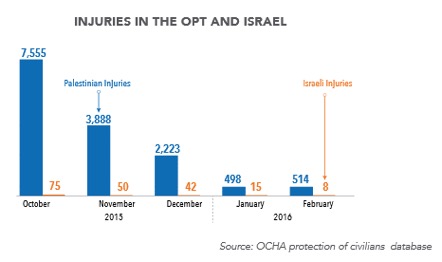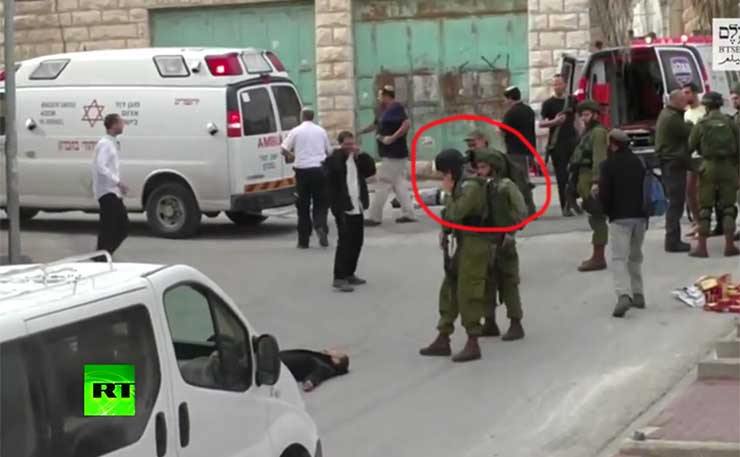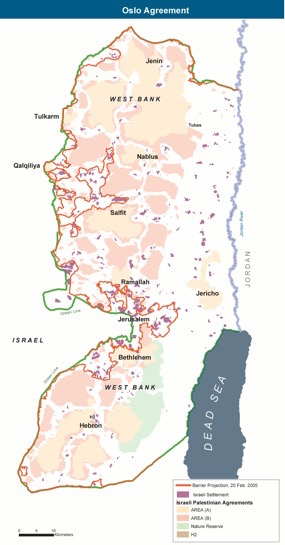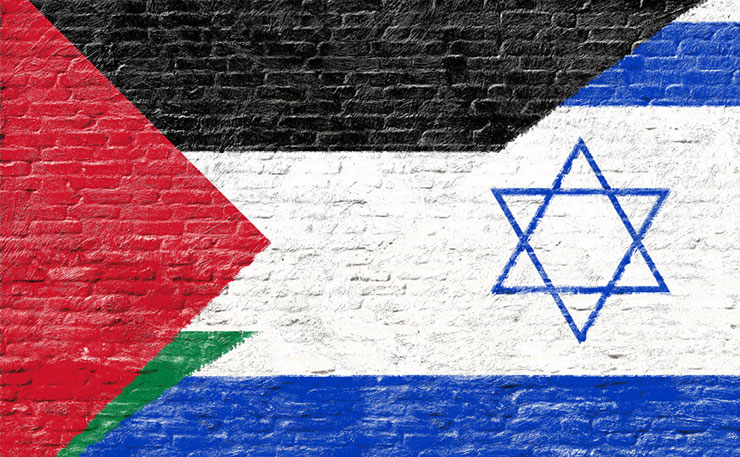With the Palestinian Authority being handed a greater role in response to the attacks, things look to be calming for now. But the hopelessness that underscored the wave of violence won’t be overcome so quickly, writes Michael Brull.
It appears the stabbing intifada in Israel and Palestine is winding down. Though Israel’s response has been brutal, it has, in some ways, offered a relatively targeted brutality. One of the crucial elements of Israel’s successful defeat of this movement has been the crucial supporting role of the Palestinian Authority.
The Attacks Are Slowing
The stabbing intifada began in October last year, in the context of a series of provocative moves by right-wing Israeli politicians and the Israeli government in relation to Haram al-Sharif/the Temple Mount. On October 1, two settlers were murdered in the West Bank. This was followed by various stabbing attacks, many of them by Palestinian residents of East Jerusalem. While stabbings were the primary method of Palestinian attack, other Palestinians shot Israelis, or rammed them with their cars. Some of the attacks were directed at Israeli soldiers and police, others directed at Israeli settlers, some at completely randomly chosen civilians. Human rights organisations have failed to break down these figures.
 According to the United Nations, in October and November, 18 Israelis were killed and 125 were injured. During this time, 61 Palestinians who were suspected of either stabbing Israelis, or trying to stab Israelis, were killed by Israeli forces. An additional 39 Palestinians were killed in unrelated incidents, such as at protests, and other clashes with Israeli forces. Over 11,000 Palestinians were injured in those two months alone. The number of injuries rapidly declined, as Palestinian protests and activism more generally died down. Those protests addressed issues including the occupation, East Jerusalem, solidarity with hunger striking Palestinian prisoners, and Gazans expressing solidarity with the West Bankers.
According to the United Nations, in October and November, 18 Israelis were killed and 125 were injured. During this time, 61 Palestinians who were suspected of either stabbing Israelis, or trying to stab Israelis, were killed by Israeli forces. An additional 39 Palestinians were killed in unrelated incidents, such as at protests, and other clashes with Israeli forces. Over 11,000 Palestinians were injured in those two months alone. The number of injuries rapidly declined, as Palestinian protests and activism more generally died down. Those protests addressed issues including the occupation, East Jerusalem, solidarity with hunger striking Palestinian prisoners, and Gazans expressing solidarity with the West Bankers.
From December to January, two Israelis were killed each month. Israeli injuries dwindled from 42 in December, to 15 in January, to eight in February. While 24 Israelis were killed between October and December by Palestinians from the West Bank, none of the attacks by West Bank Palestinians happened within Green Line Israel.
The trend of a decline in violence, already observable in February, has continued. In the week of 29 March to 4 April, the UN commented that “For the first week in almost six months there have been no Palestinian nor Israeli fatalities recorded.”
Israeli intelligence has also observed a decline. A Shin Bet official “told the Israeli cabinet on Sunday that Palestinian attacks had dropped significantly in the past month, with 20 occurring during March compared to 78 in October.” Ha’aretz reported Shin Bet’s contention that since “October 1, Palestinians have perpetrated 270 attacks, most of these shootings, stabbings and car rammings, killing 29 Israelis and four foreign citizens, and wounding another 250 people”. Likewise, the Israeli army has also found a decline. Whereas it claimed there were 620 attacked in October, there were 155 in February, and fewer still in March.
Israel’s Response

International Crisis Group analyst Nathan Thrall observed that the odds were “stacked overwhelmingly” against the stabbing intifada becoming a “sustained uprising”. Knowledgeable observers tended to regard the choice of tactics as a sign of despair. As leading Israeli journalist, Nahum Barnea put it, “Terrorism is the rotten fruit of despair”. Isolated individuals, miserable under occupation, lashed out in hopeless attempts at violence. These were often unsuccessful, and they were more or less certain to result in death. Palestinians who engaged in these attacks must have known the prospect of these attacks achieving any type of change was negligible. Particularly troubling about this type of nihilistic violence is that most of the attackers were less than 20-years-old. That is, it is Palestinian youth who appear to have given up on the prospect of constructive activism and change.
Given that the attacks are the fruit of youth and despair, it is hard from the point of view of the Israeli government to prevent attacks that are, as described by Amos Harel, “conducted from the grass-roots and… not directed by a central leadership”. Obviously, the best way to prevent attacks would be to end the despair, by ending the occupation, and offering Palestinians hope for a better future. This was never on the table. Yet Israel’s response, which combined a targeted iron fist, with a comparative reluctance to engage in collective punishment, has still been somewhat effective.
Defence Minister Moshe Ya’alon explained that “We rarely imposed closures and encirclements… After all, that’s the best way to get the masses out into the streets. We transfer the requisite tax money to the [Palestinian] Authority. After all, it’s Palestinian money.” Veteran Israeli journalist Ben Caspit described this as a “soft approach”, as these measures would have been more or less standard under earlier governments. For example, Harel notes that Ariel Sharon responded to the Second Intifada with “far more aggressive tactics, including closures, curfews, the surrounding of villages, attacks by whole divisions accompanied by tanks, numerous assassinations of central terror operatives and mass arrests”.
From the beginning of the latest uprising, if that’s what it can be called, Barnea reported that an Israeli military source outlined their tactical aim: “Avoiding collective punishments contributes to quiet. Treating the populace with an iron fist increases terrorism.” Access to villages and towns has been cut off but only in a “temporary and incomplete” manner. The Israeli media has long stressed that Ya’alon has sought to keep a “clear distinction… between terrorists and the general Palestinian population, and that if at all possible collective punishment – like keeping Palestinians from working in Israel – should be avoided.”
Ben Caspit argues that this policy “succeeded in ‘dividing and conquering’ the Palestinian public. Close to 200,000 Palestinian workers earn their living in Israel, and these workers feed more than a million people in the West Bank.”
The pride of Israeli media in this “soft” approach should not obscure its more targeted cruelty. Left-wing Israeli journalist Gideon Levy observed that the Chief of Staff of the Israeli Army, Gadi Eisenkot deserves praise for not imposing curfews. Yet Eisenkot has also embraced the policy of Israeli soldiers shooting dead all Palestinians suspected of stabbing attacks. Levy notes that “good, nice man, Eisenkot, knows there’s another way. That almost every young girl holding a pair of scissors can be stopped without killing her. That only cowardly soldiers kill children as a first resort. Eisenkot knows that if he only issues the order, the number of Palestinians who are killed will plunge drastically, without endangering the life of a single Israeli.” And yet, “This is a policy – to kill, kill and kill. No taking prisoners, no arrest procedures, no rules of engagement. Every knife or scissors wielder, every stone or firebomb thrower and every car rammer – or anyone who is seen to resemble one – must die… Eisenkot knows that his army is now sowing hatred the likes of which hasn’t been known in the occupied territories.” But that will be someone else’s problem, during the next uprising.
The Israeli army has also engaged in a policy of punitive home demolitions. On 4 April, Israeli forces demolished three apartments, belonging to the families of three Palestinians involved in an attack on an Israeli Border Police officer in February. Apparently unsatisfied with killing the three assailants, the demolitions left 22 people homeless, including four children. Since the start of the stabbing intifada, B’Tselem notes that “Israel has stepped up house demolitions as a means of punishing relatives of individuals who perpetrated attacks or were suspected of perpetrating or aiding such attacks.” There have been 36 demolitions or home sealings during this period, leaving 147 people homeless. All of this constitutes collective punishment – but by Israeli standards, it is relatively discriminate.
| 2015 | No. of apts. demolished by official order | No. of nearby apts. rendered uninhabitable | People left homeless | Minors left homeless |
| October** | 3 | 2 | 19 | 10 |
| November | 6 | 8 | 39 | 17 |
| December | 2 | 4 | 27 | 16 |
| Total | 11 | 14 | 85 | 43 |
* In addition, in July, Security forces sealed one home in East Jerusalem in July, making six people – including one minor – homeless.
** In addition, in November, security forces sealed a room in an apartment in East Jerusalem.
| 2016 | No. of apts. demolished by official order | No. of nearby apts. rendered uninhabitable | People left homeless | Minors left homeless |
| January | 2 | – | 14 | 6 |
| February | 2 | – | 15 | 9 |
| Total | 4 | – | 29 | 15 |
Source: B’Tselem
The circle of Palestinians targeted by Israeli murder, shootings, tear gassings, house demolitions, administrative detention and so on is relatively small, as compared to those who would have been affected by closures and curfews. Israeli policy was to leave as many Palestinians as possible with a stake in the status quo, and hope that it would gradually overwhelm even the desperation of Palestinian youth.
Why The Attacks Have Declined
Harel, the Ha’aretz military correspondent, discusses a few of the factors that have limited and contained the uprising. One is the “massive police deployment” on the seam between East and West Jerusalem, which diminished the number of attacks in Jerusalem. Another is Israel limiting provocations on the Temple Mount by right-wing Jewish fanatics, though Harel warns that more Jews may visit around Passover (starting April 22). Harel says the Israeli military claims it has been successful in detecting and preventing attacks through monitoring Palestinian use of social media.
Another reason is “the improved security coordination with the Palestinian Authority and its relative restriction of incitement on its official media outlets.” They have been “arresting people, while holding talks in schools to persuade students not to carry out attacks that would probably get them killed.” Harel reported that “Ya’alon and the military attribute a great deal of the improvement to the vigorous activity of the Palestinian security forces, under the direct orders of Palestinian Authority President Mahmoud Abbas”. It is “now responsible for a systematic campaign of arresting terror suspects and for conducting an information and deterrence campaign in West Bank schools.” For example, last weekend, in “what looked like an operation coordinated with Israel, three Palestinians who had disappeared from their homes a few days before and were feared to be planning a terror attack were arrested by PA security forces in Ramallah in possession of weapons.”
Central Command chief Maj. Gen. Roni Numa explained to Israel’s diplomatic-security cabinet that, according to Barak Ravid, “until a few months ago, Israel was handling 85 per cent of counterterror activity in the West Bank and the PA only 15 per cent. But today, he said, the Palestinians are handling about 35 per cent, and Israel’s share is down to 60 per cent.” It is because of this success that the Israeli army “has been advocating reduced military activity in areas controlled by the Palestinian Authority (A areas,), except for ‘ticking bomb’ cases.”
 Thus, since February this year, Israel has been negotiating with the Palestinian Authority for it to retake control of West Bank cities. These are part of what is called Area A under the Oslo 2 Accord Israel signed with the Palestinian Liberation Organisation in 1995. Area A comprises a series of isolated islands of territory in the West Bank, which were supposed to be under complete Palestinian control. This was quickly abrogated by Israel, which invaded these areas in the Second Intifada. Israel’s proposal has been rejected by the Palestinian Authority, not wishing to legitimise its incursions into Area A, which constitute violations of the Oslo 2 Accord.
Thus, since February this year, Israel has been negotiating with the Palestinian Authority for it to retake control of West Bank cities. These are part of what is called Area A under the Oslo 2 Accord Israel signed with the Palestinian Liberation Organisation in 1995. Area A comprises a series of isolated islands of territory in the West Bank, which were supposed to be under complete Palestinian control. This was quickly abrogated by Israel, which invaded these areas in the Second Intifada. Israel’s proposal has been rejected by the Palestinian Authority, not wishing to legitimise its incursions into Area A, which constitute violations of the Oslo 2 Accord.
The Israeli military’s enthusiasm for the PA to increase its involvement and authority in the West Bank indicates their faith that the PA will uphold its interests and protect Israelis from Palestinians. Numa said that “Palestinian security officials had stressed that the constant IDF incursions into Palestinian cities were undermining their position among the Palestinian public and making it harder for them to operate, and therefore, they wanted these incursions to stop”. If “the Palestinians do more, Israel can do less, and that means fewer soldiers risking their lives for the same security outcome, Numa argued.”
The increased Palestinian role has indeed had this effect. As reported by Gili Cohen, there are “Far fewer brigades” deployed in the occupied territories than in previous intifadas. Right now, “there are 26 or 27 brigades in the West Bank, whereas in the intifada, that number was as high as 80.” Part of this is because the scale of revolt and attacks is less than that of the earlier intifadas. But part of the diminished cost to the occupied Israeli forces must be attributed to the increased 20 per cent burden that has been shouldered by the Palestinian Authority.
Let us suppose that the stabbings entirely end by May. This will not resolve Israel’s problems. As noted in Ha’aretz, “The violence in October came as no surprise. For months, various defence officials, including the office of the Coordinator of Activities and the heads of the Central Command, have been warning that the despair of the young Palestinian generation in the West Bank – engendered by the absence of both economic options and a peace process – could lead to a violent outburst.” None of this will change if the uprising is crushed. Indeed, an Israeli triumph could well make them feel more hopeless. Israel’s problem will remain: it will still rule over millions of disfranchised people, sullen, crushed, and desperate. An Israeli reprieve from violence can and will only ever be temporary, so long as they continue to subjugate the Palestinians.
Donate To New Matilda
New Matilda is a small, independent media outlet. We survive through reader contributions, and never losing a lawsuit. If you got something from this article, giving something back helps us to continue speaking truth to power. Every little bit counts.





